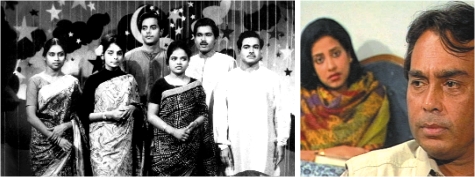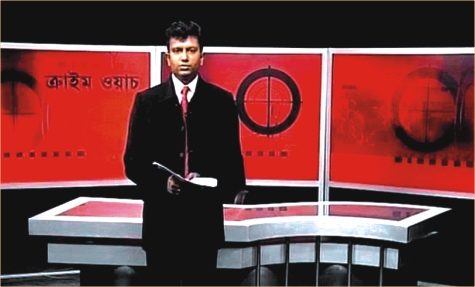 |
|
 |
|
 |
 |
|
 |
|
 |
|
 |
|
 |
|
From humble beginnings, television has transformed into the dominant entertainment medium in the country. Novera Deepita explores the journey that Bangladeshi television has taken to its position of pre-eminence in the culture today.
From BTV to ETV and beyond: The television revolution
Television is by far the most popular entertainment media in Banglad-esh. Even in this age of hi-technology with all those gadgets like the PC, game consoles, the Internet, and MP3 players, the little box in the cosy corner of one's room that flashes out hundreds of channels providing entertainment as well as information several times a day remains the number one.
The beginning
The only state-owned television channel, Bangladesh Television (BTV), started its journey on December 25, 1964, as a pilot project in the then East Pakistan, airing a song by the legendary Ferdousy Rahman. The black-and-white transmission of the channel initially began from the erstwhile DIT Bhaban (present Rajuk Bhaban) on a four-hour basis.After the independence of Bangladesh, in 1972, the previously autonomous organisation was made a full-fledged government department; in 1975, the offices and studios were shifted to Rampura.
BTV started colour transmission in 1980 through a programme named Desher Gaan produced by composer Selim Ashraf, who was a child artiste of the channel when it launched.
In 2004, the terrestrial earth-satellite based BTV launched its satellite transmission under the name of BTV World.
As the first television channel, BTV has a history of telecasting milestone productions in the last 41 years. The first drama on BTV, Ektala Dotala, written by martyr Munier Choudhury, was aired in the year of its launching. The story of a young man falling for the girl who lives upstairs starred the popular couple, Syed Ahsan Ali Sidney and Ferdousy Majumder.
It was a one-take play as all the programmes used to be aired live from the studio. "I still remember the enthusiasm among everyone involved with the production," says Majumder. "We re-shot the play in 1989 on the occasion of the silver jubilee of BTV."
Indeed, the plays have been the most popular items on BTV because they portray the everyday life of ordinary people with whom the viewers can easily identify, says Nawajish Ali Khan, senior vice president (programming) of ATN Bangla. Being one of the most successful producers of BTV, Nawajish says, "In the 1960s-1970s, when very few plays used to be staged as there were limited numbers of theatre groups, it was BTV that created many great actors and producers."
Landmarks of BTV
In 1979, a new concept of magazine programme was developed by celebrated media personality Fazle Lohani. "Inspired by the idea of The David Frost Show on BBC, Lohani started the programme Jodi Kichhu Mone Na Koren. A completely new experience for the BTV audience, it ultimately turned out to be the most popular show on the channel," comments Selim Ashraf, who was the music director of the show. The programme featuring skits, quiz rounds for the audience, and other entertaining items, was recorded in presence of a live studio audience.The history of BTV also witnessed the start of drama serials and their huge popularity. Shokal Shondhya in the 1980s was one that gained huge popularity among the audience because it portrayed the lifestyle of middle class people. Other successful productions include Fodor Dostoyvsky's The Idiot adapted by Abdullah Al Mamun, Mustafa Monwar's version of Rabindranath Tagore's Raktokarobi and William Shakespeare's The Taming of the Shrew.
Prominent television and theatre actor Shahiduzzaman Selim also counts Nasiruddin Yusuf Bachchu's Bhangoner Shobdo Shuni and Selim Al Din's Chhaya Shikari as the noteworthy serials of BTV. He says: "Atiqul Haque Chowdhury, Al Mansur, and Riazuddin Badshah also produced some good single-episode plays. The plays would also present the classic world literature through a programme titled Bideshi Golper Natok."
Celebrated writer-turned-director Humayun Ahmed brought a significant change in the taste of television plays through his milestone productions Ei Shob Din Ratri, Bahubrihi, Ayomoy, Kothao Keu Nei, Aj Robibar, Nakkhotrer Raat, Tithir Neel Towaley, and Adekha Bhuban. All his serials earned huge popularity among people irrespective of their background.
Nawajish says, "After the massive success of Ei Shob Din Ratri in the 1980s, we planned to produce a sit-com type of serial with comic flavour. The result was the hilarious Bahubrihi which earned nationwide popularity. Humayun and I then planned to produce something different in taste, portraying the life of the rural people as well as a zaminder back in the British period. We started Ayomoy and for the first time we stayed outside Dhaka for a serial. The experience was unforgettable."
With the huge cast -- including Abul Khayer, Abul Hayat, Asaduzzaman Noor, Dilara Zaman, Enamul Haque, Sara Zaker, Lucky Enam, Subarna Mustafa, and Tarana Halim -- the serial was based on the feudal history of the land, showing the truth that "society has a changing nature in which dynasties tumbles down one after another," says Nawajish.
Ferdousy Majumder says, "The earlier TV plays had very strong scripts and the productions were very rich in quality. There are hardly any parallel production nowadays like Baraf Gola Nadi, Raktokarobi, Drishtidan, Jogajog, and Shangshaptak."
The national television children's competition Notun Kuri, which is still running, started in 1976. The most important contribution of the programme is that it has produced many talented artistes of the time. Tarana Halim was one of the prime champions of the competition. Other popular faces on television -- including Rumana, Rashid, Ishita, Tarin, Mim, Nusrat, Imroz, and Tisha -- all are from Notun Kuri.
Started by pioneer puppeteer of the country and popular BTV producer Mustafa Monwar, the competition was initially Dhaka-centred. But soon it gained wide acclaim of the critics and Mustafa Monwar was asked to make a similar show for the Lahore station of the Pakistan Television: "Later, when the competition re-started in 1976 with wider arrangements, around 200 children participated in the competition in 12 basic categories of all performing arts, including classical music, Rabindra Sangeet, Nazrul Sangeet, folk song, dance, acting, and instrumental."
In recent times, Hanif Shanket's Ityadi has been the most popular magazine show on BTV. Although many say that the show offers cheap entertainment for common people, the audience belonging to all classes enjoys watching the show.
Television commercials
According to Nawajish Ali Khan, "The first television commercial was made in 1967 for a detergent soap 707. General Manager of Karachi TV Aslam Azhar was asked to make a commercial for that soap. The seven-second commercial showed a lady holding up the soap after washing clothes and saying, "Mai to janu sidhi bat, sabun ho to saat so saat."In the 1980s, there was a revolution in the commercial trends thanks to the involvement of youngsters in the ad industry. One must mention the name of Afzal Hossain in this regard. "Through his creative productions, he offered a new profession, a new type of artistes known as models. Today advertisement has become a very big business," says Nawajish.
Gradually, cartoon characters, computer-generated graphics, jingles, story-based scripts and popular models -- both male and female -- were incorporated in the industry to usher in all the new trends.
Shahiduzzaman Selim points out another trend, especially featured in the commercials of the present time. "Amitabh Reza introduced the idea of using timeless songs in commercials with the Shareng Bou soundtrack Orey Neel Doria. The latest example of this is GrameenPhone's Kotodur Ar Kotodur Bolo Ma directed by Mostofa Sarwar Faruqui," Selim says. "The small-screen directors are now taking interest in making commercials."
New era
In 1994, BTV achieved another milestone through telecasting the first private production, a one-hour play Prachir Periye, directed by Atiqul Haque Chowdhury and featuring Noble and Bipasha Hayat. Based on a story of Kazi Anwar Hossain's popular Bangalee secret agent Masud Rana, it was the first play on the espionage world.When the satellite dish arrived commercially in 1995, the viewers got many options for watching programmes from different countries. The impact of satellite TV culture began to transform the lifestyle of the people of this region and the role of electronic media was felt in every sphere of life. The result was Bangla satellite channels.
ATN Bangla
On July 15, 1997, the first Bangla private satellite channel ATN Bangla started operation with an aim of telecasting news and programmes in Bangla to be viewed in more than 100 countries.In 1997, West Bengal started exchanging programmes with ATN Bangla and its popularity soared. In May 1999, the channel switched over from analogue to digital technology: the screen became brighter and more attractive. Next year, the channel extended its transmission to Europe and beyond. On August 16, 2001, ATN Bangla started broadcasting its own news bulletins. In 2003, ATN Bangla achieved wide appreciation for its coverage of the Iraq war by introducing hourly news bulletin.
The most noteworthy success of ATN Bangla is of course winning the 32nd Academy of Television Arts and Science (EMMY) Awards in 2002 for its production Amrao Pari (We, too, Can). A documentary directed, shot, and edited by eighteen Bangladeshi teenagers, it is the true story of a boy named Abul Khaer. On an early July morning in 1996, the nine-year-old stopped a passenger train that was approaching a disjointed track on the Boaljhuri Bridge. The young team of the programme Amra Korbo Joy recreated the whole incident on film.
Half of the eighteen teenagers were already household names for their participation in ETV's Muktokhobor. When the television channel went off the air, these children along with the programme's producer Rowshon Ara Rukhsana Sirkar Nipa decided to join ATN. Nipa says, "Eighteen children, half of whom are underprivileged, worked on this programme, and our motto was, 'by children, for children, to everyone'."
Channel i
The first digital Bangla satellite channel, Channel i started its journey on October 1, 1999. The two founders had already been involved with the Impress Telefilm Ltd, which emerged as a pioneer television production house.Apart from telecasting regular television plays, serials, musicals, magazine shows, children's shows and game shows, Channel i was the first to popularise the idea of video jockey (VJ). A bunch of young and enthusiastic VJs were one of the main attractions the channel offered to the young generation.
Channel i in 1999 started the first daily soap of the country named Jowar Bhata, directed by Abdullah Al Mamun and featuring many popular and promising artistes. The serial is also the first to touch the 100-episode landmark.
Hridoye Mati O Manush hosted by Shykh Seraj has been one of the most popular agro-based programmes on the channel. Literally the second season of the BTV programme titled Mati O Manush, which was immensely popular both among the farmers as well as other common viewers, the Channel i programme completely revived its popularity.
Among live talk shows Muhammad Jahangir's GrameenPhone Tele Shomoy, covering contemporary issues, gained huge popularity.
It is also Channel i that has launched the first superstar hunt programme titled Lux Channel i Superstar this year.ETV
Launched in April 2000 as the country's first private terrestrial TV channel, Ekushey Television (ETV) covered half the country's population and turned out to be the most popular channel offering brisk, highly professional, and path-breaking programmes.The channel sparked a revolution in television journalism. The objective, deeply analytical, interpretative and investigative reports by a bunch of young and enthusiastic journalists has a serious impact on society.
Reporting reached an international standard and for the first time reporters enjoyed stardom. ETV immensely encouraged women towards journalism as a profession.
Nawajish Ali Khan, who was involved with the ETV, says, "Ekushey was an organised and professional media, which was accumulated by professional, creative, talented and committed people. To ensure quality the authority trained up the behind-the-scene people as well as the artistes and performers of a programme."
The ETV productions were unique in nature: children's programme Muktokhabor, for instance, was a news-based show in which the child performers would handle news with social relevance. Fifty percent of the young team were from underprivileged families.
To name other successful items, entertainment programmes Ekusher Dupur, Priyotomashu, quiz show Shobdo Jabdo, Shofol Jara Kemon Tara, informative programme Ekatturer Ei Diney, Ajker Shongbadpotro, Ei Shoptaher Biswa, talk show Amrao Boltey Chai, cookery show Radhunir Rannaghar, and of course a number of plays by gifted directors.
Another popular actor, Mahfuz Ahmed says, "Ekushey played a vital role in promoting talented young artistes the result of which was so obvious -- many innovative ideas and commitment produced quality programmes and the channel gained huge popularity within a short time."
However, ETV went off the air on August 29, 2002 after losing a legal battle over its broadcasting rights.
An emotional Abdullah Abu Sayeed, founder of the Bishwa Shahitya Kendra, wrote a commentary in the daily Prothom Alo on September 18, 2002: "ETV has been leading our seemingly aimless youth to a healthy and capable citizenship through its promising and unique programme roster. ETV protected the Bangladeshi viewers from the formidable influence of the satellite-culture and steered them gently to the tasteful bouquet of Bangla programmes, discarding the Hindi channels."
Ntv
Another satellite channel ntv was launched on July 3, 2003, with the modern technical support and the trained crew of the ETV, which earned the channel popularity.An array of diverse programmes, including quiz show Medhabi, talk show Alochon, fashion programme Fashion Talkies, cookery show Siddiqua Kabir's Recipe, lifestyle show Gharbari Thikthak, teen magazine Amra Ekhon Unish Kuri added to the success of the channel. Drama serials and plays like Jhut Jhamela, Kachher Manush, Ronger Manush, Titumirer Bansher Kella, Romizer Ayna, Sporsher Bairey and Rangchhut became household names to the audience.
However, the most popular item on ntv is of course the talent hunt show Close Up 1: Tomakei Khujchhey Bangladesh in search of the "singer of the nation" singled out from thousands of contestants. The show also introduced the audience's vote through cell phones and Internet.
New trends
Bringing new trends and aspects is very important in every media to keep the ball rolling on. The trendsetter in case of every type of programmes was Ekushey Television. Apart from the innovative and unique programmes mentioned earlier, Ekushey was the first network that gave liberty to the makers to create huge sets for programmes and television plays.Actress-turned-director Afsana Mimi directed the most popular mega serial of Ekushey TV, Bandhan. Sharey Tin Tola, Grihogolpo, and Kachher Manush are her other popular mega serials, Mimi, who designed the set for all of her serials, says, "I have noticed that the sets had no similarity with the characters and story, with only a few houses being used as the shooting spots, which ultimately made things monotonous for the viewers. I took up set designing to bring a change in the scenario. The audience has always appreciated me for doing something different. They say my sets are eye-catching. I have enjoyed the liberty to arrange the sets according to my thoughts."
Shahiduzzaman Selim thinks, "For instance, Faruqui's Ekannoborti, Choruibhati and 69 -- all these serials and plays introduced realistic direction by incorporating informal language and improvisation in dialogues, natural acting, different styles in characterisation, camera work, location and set designing."
With many new channels like RTV, STV and Channel 1 ready for airing, many new types of shows are now seen with different arrangements on the small screen: talk shows, magazines, children's shows, talent hunts, mega serials, quiz shows, telefilms, live shows, music videos, game shows, beauty contests, theme songs, and even movie premieres.
The new channels have brought in technical support, topics, novel acting style, better photography, crisper dialogue, shot divisions, and improvisation. The changes came when BTV started private productions. A door to a new age opened to those who are truly creative. The future is so bright that the entire industry needs to wear sunglasses!
......................................................................
Novera Deepita is a reporter of The Daily Star.

